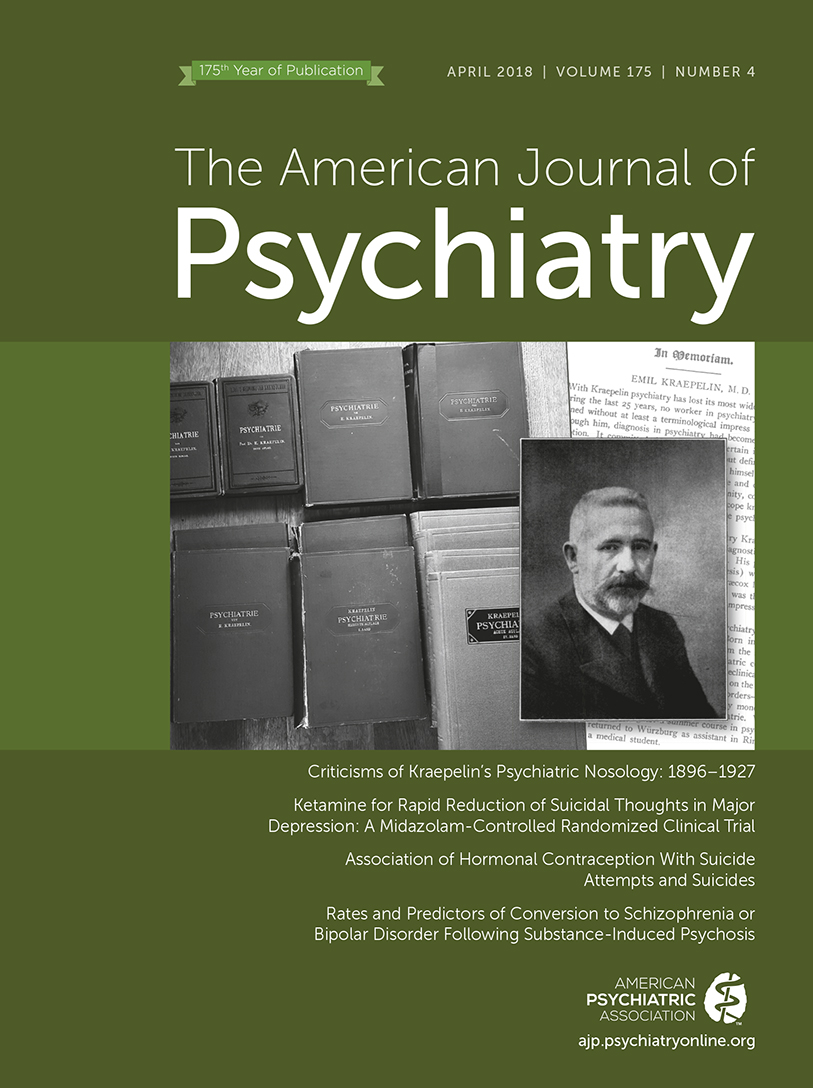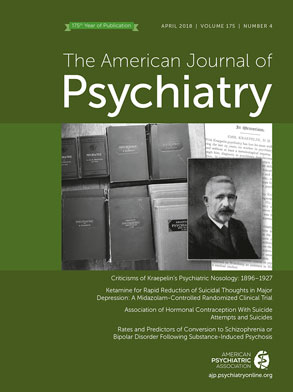Drugs of abuse and alcohol are known to acutely induce psychosis. Distinguishing between substance-induced psychosis, primary psychotic illnesses, and psychotic illnesses with comorbid substance use is clinically challenging. If the psychotic symptoms diminish as the psychoactive substance is metabolized and excreted, a diagnosis of substance-induced psychosis is typically made and substance use treatment is recommended, but, unfortunately, these patients are often lost to follow-up (
1). There is growing recognition that this patient group may constitute a high-risk group for the development of a primary psychotic illness. Recent studies provide evidence that individuals with substance-induced psychosis are more likely to develop a schizophrenia spectrum disorder (
1) or a primary psychotic disorder (
2,
3). A recent large register-based study from Finland reported an increased risk of conversion to schizophrenia following an episode of substance-induced psychosis (
4).
In this issue, Starzer et al. (
5) report on a register-based study designed to determine whether individuals diagnosed with substance-induced psychosis and no prior record of schizophrenia spectrum or bipolar disorder converted to either schizophrenia or bipolar disorder over a 20-year period. The authors delved into the Danish Civil Registration System and the Psychiatric Research Registry and identified 6,788 individuals with substance-induced psychosis and 67,227 matched control subjects for between-substance comparisons. The main results demonstrate that 32% of individuals with any substance-induced psychosis later converted to either schizophrenia or bipolar disorder, with a majority (26%) given the former diagnosis. Half of those who converted to schizophrenia or bipolar disorder did so within 3 years or 4.5 years, respectively, after the incident substance-induced episode.
This cohort included large numbers of cases with alcohol-induced (N=2,315), cannabis-induced (N=1,492), and amphetamine-induced (N=555) incident psychotic episodes and smaller numbers of other drug-induced incident psychoses (Ns from 114 to 158), which allowed the authors to meaningfully examine the influence of individual drugs on rates of conversion. Individuals using more than one drug were classified separately. When conversion rates over 20 years were calculated, cannabis was associated with the highest conversion rate to schizophrenia or bipolar disorder, 47%, followed by amphetamines, with a conversion rate of 32.3%. Conversion rates for alcohol, hallucinogens, cocaine, opioids, and sedatives were in the 20%−28% range.
There were substantial differences between the rates of conversion to schizophrenia and bipolar disorder. Overall, the conversion rates to schizophrenia following substance-induced psychosis were higher than for bipolar disorder and were dependent on the specific substance implicated. Cannabis and amphetamines were the main culprits associated with higher rates of conversion to schizophrenia. For those who converted to bipolar disorder, however, the type of substance used did not have a differential impact on conversion rates, a result of broad confidence intervals that may reflect the smaller number of individuals who convert to bipolar disorder. Another reported difference is that younger age at occurrence of substance-induced psychosis (16–25 years) was associated with higher rates of conversion to schizophrenia, a pattern that was not seen for bipolar disorder. The authors also examined predictors of conversion and found that personality disorders and self-harm following the incident substance-induced psychotic episode were associated with higher rates of conversion to both schizophrenia and bipolar disorder.
It is notable that when we compare results from this Danish register-based study with those from a study based on the Finnish registry (
4), there are striking similarities. In both studies, the conversion to schizophrenia was highest after psychosis induced by cannabis, followed by amphetamines and hallucinogens. This consistency between separate studies lends greater confidence to the findings. Furthermore, these observations are consistent with epidemiologic and longitudinal studies that found positive associations between cannabis use and development of psychotic illnesses (
6) and give credence to the hypothesis that cannabis use is a risk factor for the emergence of psychosis and that individuals with a vulnerability to psychotic illness are particularly sensitive to the effects of cannabis (
7).
There are certain caveats that should be borne in mind. Although register-based cohort studies have the major advantage of large sample sizes that are generalizable to the general population, they do have limitations. The accuracy of the information captured in the databases by a variety of clinicians over the years is assumed to be accurate for conducting these analyses. It is also possible that an undiagnosed primary psychotic illness was present before the incident substance-induced psychotic episode. The authors acknowledge the inherent shortcomings with this approach but also point out that conversion rates increase at a steady rate over the 20-year study period, which bolsters the validity of the results. Although not possible in this study, more information about substance use history, including amount and frequency of drug use, as well as continued substance use following the incident substance-induced episode, may be important clinical variables when considering conversion to primary psychotic illnesses.
Nonetheless, these intriguing data make a significant contribution to our understanding of the relationship between substance-induced psychosis and the development of serious psychiatric illnesses. To summarize, the strongest data from this study indicate that 1) substance-induced psychosis is associated with the later development of schizophrenia and, to a lesser degree, bipolar disorder; 2) half the patients who experience a cannabis-induced psychotic episode will go on to develop schizophrenia; and 3) a substance-induced psychotic episode at a younger age increases the chances of conversion to schizophrenia.
This study makes an important contribution to our understanding of the temporal relationship between substance use and development of psychotic illnesses and suggests that substance-induced psychosis may be an indicator of the future development of schizophrenia or bipolar disorder. This information can be used by clinicians to improve care of their patients. Specifically, the findings provide concrete data to use in psychoeducation and provide a strong rationale for close clinical follow-up and perhaps even earlier treatment interventions.

